
Structual
Stations
Midland Station, Nottingham
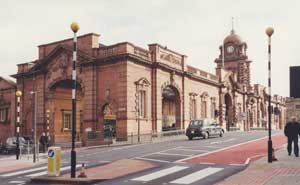
Midland Station, Nottingham.
There have been three Midland Railway stations in Nottingham. The first station was built in 1839 on Carrington Street as the terminus to the MCR branch line from Derby. Two gate piers are all that survive of the building. The second station was built on Station Road in 1848 and demolished in 1902. The current station was designed by A E Lambert and opened 17 January 1904. It is similar to the MR station at Leicester and has a distinctive terracotta facade surmounted by a clock tower. The frontage with its porte cochere and booking hall was built on a bridge over the railway.
Victoria Station, Nottingham
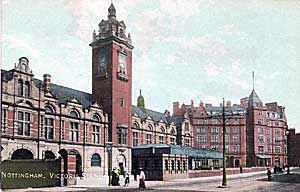
Victoria station, c.1910.
The building of the station was jointly financed by the GNR and GCR and it was originally called the Nottingham Joint Station. However, the name was not generally liked and it opened as ‘Victoria’ station on the Queen’s birthday (24 May) in 1900.
Construction of the station was on a massive scale, involving the excavation of 700,000 cubic yards of sandstone rock and the demolition of 1,300 houses, 24 pubs and the Nottingham workhouse.
The main station building was built using the best quality faced bricks and Darley Dale stone. The three story building had a large 100 foot clock tower in its centre topped with a cupola and weather vane. At the north end of the building access could be gained to the parcels office via two large metal gates.
The station was closed in 1967 and demolished. A shopping centre now occupies the site and the clock tower has been preserved at the west entrance.
- Listed building description and photograph of the Clock Tower on the Images of England website
- Entry on Nottingham Victoria on the Disused Stations website
London Road (Low-level) Station, Nottingham
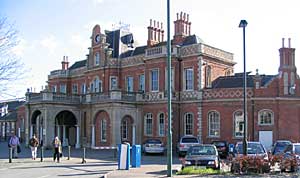
London Road (Low-level) station.
The impressive brick station building, designed by T C Hine, was built by the GNR in 1857. The station was disused from 1900, and was used as a parcels depot from 1944-1985. It was restored and converted to a gym in the 1990s.
The adjacent semi-derelict Great Northern warehouse, also by T C Hine, is contemporary with the station.
Beeston station
Built for the Midland Railway in white brick and opened in 1847.
Retford station
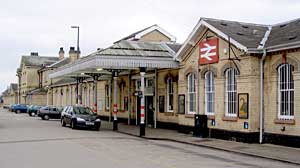
Retford station in 2006.
The current station on Station Road was built by the Great Northern Railway in 1852. Part of the original station building of the Manchester, Sheffield and Lincolnshire Railway dating from 1849 still stands on Thrumpton Road.
Worksop station
Designed by James Drabble of Carlton and built “of good solid Steetley stone in the Derbyshire-Yorkshire Jacobean” style for the Manchester, Sheffield and Lincolnshire Railway in 1849.
Newark stations
Northgate station was built by the GNR c.1850.
Castle Station was built in the Early Italianate style for the Midland Railway in 1846. The associated goods shed of 1871 has recently been converted into apartments.
Mansfield station
The original 1819 terminus building of the Mansfield and Pinxton Railway at Portland Wharf was demolished in 1983 and the materials transported to the Midland Railway Centre at Butterley to be re-built. A new station was built on Station Street by the MR in 1849 to serve its Nottingham to Mansfield line; this was also demolished in 1983. The current station was constructed in local stone for the MR in 1875.
Kimberley stations
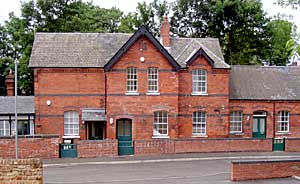
The former GNR station in Kimberley in 2007.
The GNR station was built for the Derbyshire & Staffordshire Extension in 1875-6 and has recently been restored and converted to residential accommodation; the nearby Midland Railway station formerly on the Basford to Bennerley Junction branch dates from 1882 and is semi-derelict.
Lowdham station
Probably designed by noted Nottingham architect, T. C. Hine, and built for the Midland Railway in 1848.
Tunnels
Redhill Tunnel (North Portal) Pair of tunnel entrances: east tunnel built 1840, west tunnel dates from 1875. The engineers were Thomas Jackson Woodhouse and Charles Vignoles (1840) and J. S. Crossley and J. A. McDonald (1875).
Mapperley tunnel is 1,132 yards long and was cut through a ridge in north-east Nottingham for the Derbyshire & Staffordshire Extension of the Great Northern Railway. It was brought into use in 1875 and closed in 1960.
Clarborough Tunnel of 1848 on the Manchester, Sheffield and Lincolnshire Railway is 656 yards long.
Viaducts and bridges
Portland Bridge, built for the Pinxton to Mansfield railway, dates from 1819
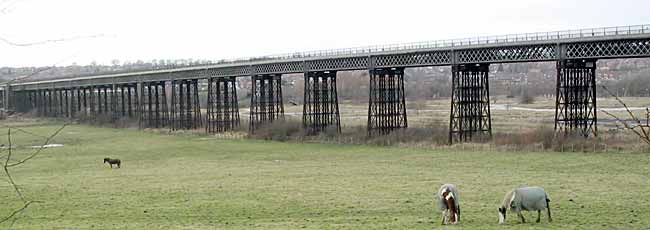
Bennerley Viaduct (2008).
Bennerley Viaduct - The viaduct carried the Great Northern Railway's Derbyshire and Staffordshire railway line across the Erewash valley between Awsworth and Ilkeston and was opened in January 1878. This impressive structure is “a steel trestle structure of sixteen spans, each of which consisted of lattice girderwork supported on piers of twelve circular columns braced together and set on stone bases.” It is over 1,440 feet long and up to 60 feet high.
The impressive 15-arch brick and stone viaduct across Mansfield town centre was constructed by the Midland Railway Company in 1875.
Stoke Bardolph railway bridge over the River Trent originally built in for the GNR in 1851 and altered in 1970.
Fledborough viaduct over the River Trent was built in 1897 by the Lancashire, Derbyshire and East Coast Railway and has fifty nine brick arches on the approaches, with steel girder spans across the river itself.
Lady Bay Bridge in Nottingham was originally built in 1878 to carry the Midland Railway line to Melton Mowbray over the River Trent. The line was closed in 1968 and the bridge was converted to carry road traffic in 1979.
Torksey viaduct over the River Trent was built for MS&LR in 1847-49 and designed by John Fowler, co-engineer of the Forth Rail Bridge in Scotland. It is a “rare surviving example of the tubular girder bridge” and consists of two 130 foot spans.
- Listed building description and photograph on the Images of England website
- Photograph and description on the Forgotten Relics website
Sidings and railway yards
Toton Sidings and Traction Maintenance Depot (Nottinghamshire) is one of the largest rail depots in the United Kingdom. Originally established by the Midland Railway in the 1850s to handle coal from collieries in the Erewash Valley, Toton grew to be one of the largest marshalling yards in Europe. Many of the yards were lifted during the 1970s and 1980s as domestic coal traffic declined.
- David M Copeland, Toton Yards and the Erewash Valley. A brief railway history (1998)
- Toton Yards photographs by Paul Robertson
- Toton railway photographs
- Toton Sidings
No trace of the extensive Colwick Yards survives: all the buildings, tracks and associated structures were demolished in the 1970s and 1980s and the site is now a retail park.
- Henshaw, Alfred. The Great Northern Railway in the East Midlands the rise and fall of Colwick Yards, Nottingham London Road, Gedling, Basford, Pt 1, Railway Correspondence & Travel Society (2001)
- Waite, Peter Barrie. A history of the Great Northern Railway's Colwick Motive Power Depot and Marshalling Yard, incorporating the Nottingham Colwick Estates Light Railway and the London & North Western Railway's Netherfield & Colwick Engine Shed, Book Law Publications (2004)
- Photographs of Colwick Yards
Annesley Sidings and the Annesley Motive Power Depot in the Leen Valley were closed and demolished in 1966.
Trackbeds
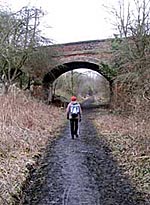
The Teversal Trail runs along a former Midland Railway line.
A number of closed lines have been converted to footpaths:
- The Southwell Trail along a section of the former MR Rolleston to Mansfield line (the path runs from Southwell to Farnsfield)
- Teversal and Meden Valley Trails follow former GNR and MR lines to the north-west of Mansfield (www.teversaltrails.com/trails.htm)
- Leen Valley Trail along the former GNR Leen Valley line (Linby to Newstead)
- Newark to Cotham railway path runs from Newark Northgate station to the village of Cotham along the route of the Newark to Bottesford railway opened in 1878.
Miscellaneous
There are several gravestones in Nottinghamshire churchyards documenting railway-related deaths.
- In the graveyard of St Mary and All Souls' church, Bulwell, William Haslam's death is described thus: "[he] was so injured by a fall from a steam engine while playing with a youth on the Bennerley and Bulwell new line on March 3rd 1877 that he died on the 4th aged 20."
- In the graveyard of St Michael's church, Linby, is a gravestone recording the death of James Stafford "who was instantaneously killed on the line of Railway Near the Village, Feb: 5th 1848 Aged 22 years"